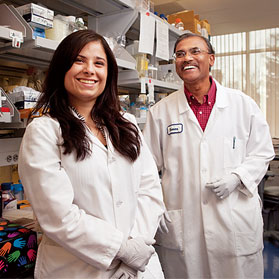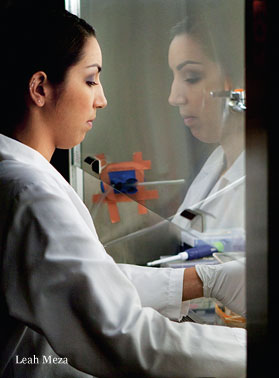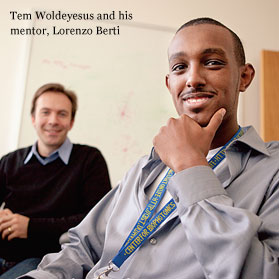First steps: An "ET-CURE" for health disparities
 Angela Echeverri-Lompre and eight other UC Davis students are at the forefront of medicine through the cancer center's Emerging Technologies Continuing Umbrella Research Experiences program (ET-CURE) (PDF 108KB).
Angela Echeverri-Lompre and eight other UC Davis students are at the forefront of medicine through the cancer center's Emerging Technologies Continuing Umbrella Research Experiences program (ET-CURE) (PDF 108KB).
For about 10 hours each week, the nine undergraduates don lab coats and work in one of four cancer center research laboratories. The students conduct research into developing new cancer diagnostic tools and therapies, and work with mentors who help guide their careers.
"I've never really had a chance to work in a lab hands-on before," says Echeverri-Lompre, 25, who immigrated to California from Colombia at 17. "It's been so extraordinary to learn what cancer can do – how it can affect the body. I want to be able to learn how we can stop this."
The goal of the ET-CURE program is twofold: Professors hope to give undergraduate students a taste of hands-on lab research, and cancer center leaders hope the experience will entice underrepresented minority students to pursue careers in cancer research and treatment.
The approach appears to be working. Echeverri-Lompre and several other students in the program say they now intend to pursue dual careers as cancer physicians and researchers.
"It's allowed me to see that I have the potential not just to treat patients, but to go into a lab to research the diseases," says Echeverri-Lompre, who transferred to UC Davis after two years at Solano Community College.
"It's allowed me to see that I have the potential not just to treat patients, but to go into a lab to research the diseases. "
That's what Marco Molinaro, director of ET-CURE and chief education officer for the Center for Biophotonics Science and Technology (CBST), is hoping to hear from participating students.
"Diversity is sorely lacking in cancer research," says Molinaro. "We wanted to create a program that would bolster the number of students who traditionally are not represented in this field, especially in upper research echelons."
The program, which started in the summer of 2009, is funded through the National Cancer Institute's Center to Reduce Cancer Health Disparities, and the National Science Foundation, which funds CBST. Another CBST program, CURE High School Research, which began four years ago, links high school students from St. HOPE Academy at Sacramento High School with UC Davis cancer scientists and clinicians. Both programs aim to increase the number of members of underrepresented groups in the sciences and, specifically, cancer research.
 "Diversity is sorely lacking in cancer research. We wanted to create a program that would bolster the number of students who traditionally are not represented in this field, especially in upper research echelons. "
"Diversity is sorely lacking in cancer research. We wanted to create a program that would bolster the number of students who traditionally are not represented in this field, especially in upper research echelons. "
"We want them to see that careers in science and medicine are doable," says Molinaro.
The push for greater representation of minority students in cancer research is grounded in the idea that physicians and researchers from underrepresented groups are more likely to treat and research cancer disparities in those groups.
For ET-CURE student Leah Meza, 22, that approach makes sense.
"Who better to serve these same individuals and groups and cultures than those who come from those groups?" says Meza, who is of Mexican and Puerto Rican descent.
Meza is pursuing an undergraduate degree in cell biology and has applied for a two-year post-bachelor's degree program at the National Cancer Institute in Maryland. Ultimately, she will apply to medical school and pursue a dual M.D. and Ph.D., possibly in oncology.
 "Who better to serve these same individuals and groups and cultures than those who come from those groups?"
"Who better to serve these same individuals and groups and cultures than those who come from those groups?"
Meza says her eyes were opened to such career possibilities by her mentor, Kit Lam, who runs the cancer research lab where she works through the ET-CURE program.
"I try to encourage them and inspire them," says Lam, professor of medicine and chair of the Department of Biochemistry and Molecular Medicine.
Lam hosts four ET-CURE researchers in his lab. He stresses that the students are not just repeating what other researchers do in the lab, but are conducting "state-of-the-art" research themselves. Meza had a paper published recently in the journal Medicinal Chemistry, Lam says.
Meza is researching peptide ligands, small proteins that bind to receptors on the surface of cancer cells. Researchers are hoping to find peptide ligands that will bind to cancer cells but not to normal cells, and use them to deliver drugs to the cancer cells for treatment.
Echeverri-Lompre is focused on pancreatic cancer, working to identify a ligand that binds to the cell surface so that physicians may one day be able to attach an imaging agent to it. The imaging agent would allow earlier detection of cancer, hopefully before it has spread to other parts of the body.
"This way, we'll be able to see where the cancer is and treat it," says Echeverri-Lompre.
 "In the perfect world, I hope I could be a professor at a medical school, having my own lab and practicing medicine. I'd like to prescribe a drug I discovered. "
"In the perfect world, I hope I could be a professor at a medical school, having my own lab and practicing medicine. I'd like to prescribe a drug I discovered. "
Tem Woldeyesus, 20, a junior at UC Davis in neurobiology and another ET-CURE student, says he "fell in love with clinical research" in Lam's lab. Woldeyesus, whose parents immigrated to the United States from the east African country Eritrea shortly before he was born, is interested in researching brain tumors.
"A lot of things that I learn in class, I apply in the lab," says Woldeyesus.
Woldeyesus says that Lam gives the students room to really analyze their lab results.
"He doesn't spoon-feed us everything," he says. "He makes us think."
Woldeyesus says that he, too, would like to pursue a combined M.D.-Ph.D. program in medicine.
"In a perfect world, I hope I could be a professor at a medical school, having my own lab and practicing medicine," says Woldeyesus. "I'd like to prescribe a drug I discovered."
Molinaro says helping ET-CURE students envision various career trajectories is a critical goal of the program. He says the mentors' approach is akin to "life coaching." Mentors help guide the students by advising them of the various programs available and then helping with the application process.
"But we take a very holistic view," says Molinaro, adding that one student is planning a stint in the Peace Corps before he pursues his medical degree.
Through the CURE program, high school students are exposed to the world of research and medicine. The students study cancer in their science classes the first semester of the program, then conduct independent research projects, typically investigating toxicology, throughout the second semester. During the summer, they conduct research in cancer laboratories with the help of cancer center researchers.
"The idea is that if you get kids interested in science at a younger age, you might open up the door for a college experience or potential career they hadn't considered," says Michelle McCombs, CURE program manager for CBST.
ET-CURE student Meza, the only member of her family to attend college, says that she now has a strong sense of certainty what she wants to do with her life – treat cancer and research cures for the killer disease.
"I've never been more sure," Meza says of her career path. "I never would have had that opportunity if not for a program like ET-CURE."


 The Center for Biophotonics Science and Technology (CBST) is the only science and technology center dedicated to biophotonics, which is the science of generating and harnessing photons – quantum units of light, such as gamma rays, ultraviolet lights and radio waves – to image, detect and manipulate biological materials. Commissioned by the National Science Foundation in 2002, CBST advances interdisciplinary exchange between the medical community and basic science researchers that will facilitate the potential for biophotonics to assist in detecting, diagnosing and treating diseases rapidly and in a noninvasive way.
The Center for Biophotonics Science and Technology (CBST) is the only science and technology center dedicated to biophotonics, which is the science of generating and harnessing photons – quantum units of light, such as gamma rays, ultraviolet lights and radio waves – to image, detect and manipulate biological materials. Commissioned by the National Science Foundation in 2002, CBST advances interdisciplinary exchange between the medical community and basic science researchers that will facilitate the potential for biophotonics to assist in detecting, diagnosing and treating diseases rapidly and in a noninvasive way. 




